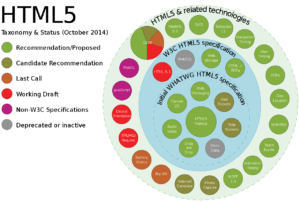Benefits of HTML5:
 1. Cross-Browser Compatibility
1. Cross-Browser Compatibility
HTML5 is easy to implement and it works with CSS3. Today all browsers support HTML5 tags and even IE6 understands the markup <!doctype html> and will render the pages correctly.
2. New DOCTYPE declaration:
The most important fact about HTML 5 is – HTML5 is easy to implement and it works with CSS3
The DOCTYPE declaration for HTML5 is very simple:
<! DOCTYPE html>
Yes, just the two words “DOCTYPE” and “html” and no more long lines of unreadable code filled with dirty tags.
3. Bring improvements in usability and user experience
Usability and user experience related to how well a website or app is designed. We all want better dynamic websites and great-looking apps that interact with the user and allows the user to enjoy the functionality, content, etc. instead of just looking at it. HTML5 has several technical enhancements and improved features for web And with HTML5 code, web developer can easily design better applications and dynamic websites which result in better user experience and usability.
4. Alternative to Flash and Silver light
HTML5 exceeds Flash and Silver light and takes the lead just because for playing the Flash file and Silver light, you will need to install Adobe Flash latest version or a Silver light plugin and you also need to keep in mind the device and the operating system compatibility. This is not the case with HTML 5. As a result, HTML5 is becoming more popular these days with companies as it offers a massive set of attributes and functions that help web developers to build beautiful websites and apps with minimum work.
5. Heavily used for mobile apps and games
The adaptability of HTML5 in mobile applications and game development increases as the HTML5 web application tool gives more flexibility to the web developer in all cases starting from the User interface (UI), development, using scripts, and others.
HTML5 is also capable of handling multimedia content without the necessity of installing plugins, and we can easily develop interactive games with this technology.
6. Clean markup and Improved Code
HTML5 has come along with clean markup and clean code that make it more accessible than the previous version. HTML 5 allows the web developer and web designer to use neater code and remove div tag and replace all the div tags with new HTML 5 elements.
7. Offline Browsing
HTML5 also offers offline browsing, which means that visitors can load certain elements on a web page without an active internet connection. Assume you’ve visited the site and somehow you are not connected to the internet now or internet connection happens to go down. With HTML5 offline caching we can still load core elements of the websites and you can view them offline.
8. HTML5 Is SEO-friendly when it comes to website crawling and indexing:
Nowadays to gain and retain top rankings in different search engines including Google, the website must be optimized with care and all necessary SEO modules. HTML 5 comes with various attributes and modules that make it easy for web crawlers to search your content and getting it indexed properly, thereby increasing its rankings in search engine search results pages. HTML5’s technology provides various features with a wide range of structural elements, semantics, form types, new attributes, and media elements making it easier for digital marketing experts and developers to focus on better search engine optimization techniques and to drive more organic search traffic.
9. Video and Audio Support
With HTML5 technology, we no longer need to rely upon third-party plugins in order to render audio and videos. You can forget about Flash Player and other third-party media players and plugins. You can make your videos and audio easily accessible with the new HTML5 .
10. Geolocation Support
With the help of Geolocation, we can easily find out where we are in the world and easily share that information with people.
In the past if we want to detect the location of a client device first we have to look at the client IP address, your wireless network connection, cell tower of your phone and latitude, and longitude. But with HTML5, a set of APIs have been developed which effectively allow the client-side device (i.e. your phones, IP, or even your desktop browsers) to retrieve geographic positioning information with JavaScript directly available to your HTML5-compatible browser.


 1. Cross-Browser Compatibility
1. Cross-Browser Compatibility